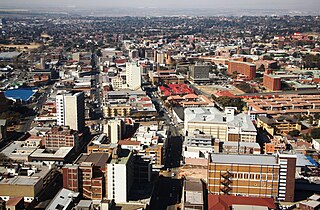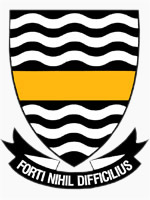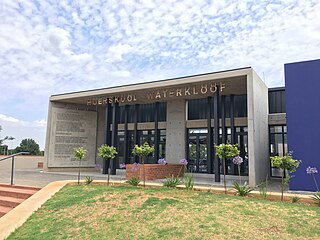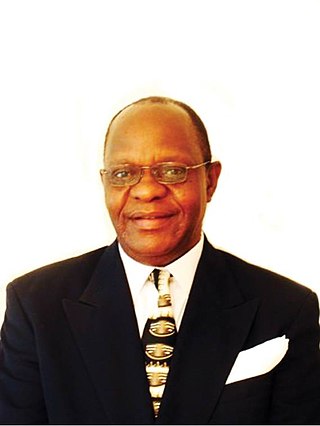
Pretoria is South Africa's administrative capital, serving as the seat of the executive branch of government, and as the host to all foreign embassies to South Africa.

The Province of the Transvaal, commonly referred to as the Transvaal, was a province of South Africa from 1910 until 1994, when a new constitution subdivided it following the end of apartheid. The name "Transvaal" refers to the province's geographical location to the north of the Vaal River. Its capital was Pretoria, which was also the country's executive capital.

Gauteng is one of the nine provinces of South Africa.

The University of the Witwatersrand, Johannesburg, commonly known as Wits University or Wits, is a multi-campus public research university situated in the northern areas of central Johannesburg, South Africa. The university has its roots in the mining industry, as do Johannesburg and the Witwatersrand in general. Founded in 1896 as the South African School of Mines in Kimberley, it is the third oldest South African university in continuous operation.

Germiston, also known as kwaDukathole, is a city in the East Rand region of Gauteng, South Africa, administratively forming part of the City of Ekurhuleni Metropolitan Municipality since the latter's establishment in 2000. It functions as the municipal seat of Ekurhuleni, hosting the municipal council and administration.

Jeppe High School for Boys is a public English medium high school for boys in Kensington, a suburb of Johannesburg in the Gauteng province of South Africa. It is one of the 23 Milner Schools, and its sister school is Jeppe High School for Girls.

Pretoria Boys High School is a public, tuition-charging, English-medium high school for boys situated in the suburb of Brooklyn in Pretoria in the Gauteng province of South Africa, founded in 1901 by Alfred Milner, 1st Viscount Milner.

The University of the Free State is a multi-campus public university in Bloemfontein, the capital of the Free State and the judicial capital of South Africa. It was first established as an institution of higher learning in 1904 as a tertiary section of Grey College. It was declared an independent Afrikaans-language university in 1950 and the name was changed to the University of the Orange Free State. The university has two satellite campuses. Initially a whites-only precinct, the university was fully de-segregated in 1996. The first black university vice-chancellor was appointed in 2010.

Hoërskool Waterkloof is a public Afrikaans medium co-educational high school situated in the eastern suburbs of Pretoria in the Gauteng province of South Africa. It is one of the most expensive Afrikaans medium schools, the fee per child amounting to R 32,400 per annum. It has received the award for academic school of the year from the Gauteng Department of Education (GDE) in 2004, 2008, 2009, 2010, 2011 and 2012. In 2018, it received the award for best academic school in Gauteng province, the ninth time since 2009. It claims a 100% matric pass rate for 30 consecutive years.
Quartus de Wet was a South African judge who served as Judge President of the Transvaal Provincial Division of the Supreme Court of South Africa.
St Dominic's Catholic School for Girls is a South African, private Roman Catholic day school located in Boksburg (Ekurhuleni), Gauteng.

Internal resistance to apartheid in South Africa originated from several independent sectors of South African society and took forms ranging from social movements and passive resistance to guerrilla warfare. Mass action against the ruling National Party (NP) government, coupled with South Africa's growing international isolation and economic sanctions, were instrumental in leading to negotiations to end apartheid, which began formally in 1990 and ended with South Africa's first multiracial elections under a universal franchise in 1994.
The University of Pretoria Faculty of Law was established in 1908. It consists of six academic departments, six centres, two law clinics, and the Pretoria University Law Press (PULP). This faculty ranked best in Africa for the fourth year in a row with leading Departments of Jurisprudence; Mercantile Law; Private Law; Procedural Law; Public Law; and Centre for Human Rights. The faculty offers the undergraduate LLB degree, and postgraduate LLM/MPhil and LLD/PhD degrees.
Johann van der Westhuizen (born 26 May 1952 in Windhoek, South West Africa is a former judge of the Constitutional Court of South Africa. Before his judicial appointment, he was a professor at the University of Pretoria Faculty of Law and the founding director of its Centre for Human Rights.
Racism in South Africa can be traced back to the earliest historical accounts of interactions between African, Asian, and European peoples along the coast of Southern Africa. It has existed throughout several centuries of the history of South Africa, dating back to the Dutch colonization of Southern Africa, which started in 1652. Before universal suffrage was achieved in 1994, White South Africans, especially Afrikaners during the period of Apartheid, enjoyed various legally or socially sanctioned privileges and rights that were denied to the indigenous African peoples. Examples of systematic racism over the course of South Africa's history include forced removals, racial inequality and segregation, uneven resource distribution, and disenfranchisement. Racial controversies and politics remain major phenomena in the country.

Safiel Percy Kachipande is a Malawian politician and former diplomat.
Anne van Zyl is a South African education administrator from Cape Town, South Africa. She is the headmistress of the Oprah Winfrey Leadership Academy for Girls. She has also been headmistress at five different schools including Pretoria High School for Girls, St. Stithians College, Stanford Lake College and Bridge House School. She is known in academic circles for her work in education, including the integration of Pretoria High School for Girls which became the first segregated white state school in the Northern Transvaal to open its doors to all races during apartheid when integrated state schools were still illegal.
AfriForum is a South African non-governmental organisation focused mainly on the interests of Afrikaners, a subgroup of the country's white population. AfriForum has been described as a white nationalist, alt-right, and Afrikaner nationalist group, though this description is rejected by the organisation's leadership, who refer to themselves as a civil rights group.
The following is a timeline of the history of Pretoria, in the City of Tshwane Metropolitan Municipality, Gauteng province, South Africa.
Zulaikha Patel is a South African anti-racism activist. She became a symbol of the fight against Pretoria Girls High School's policy regarding black girls' hair in 2016, at the age of 13. She and her classmates held a demonstration that led to not only a change in school policy, but also an inquiry into allegations of racism at the school. She is quoted as saying: “Asking me to change my hair is like asking me to erase my blackness.”












